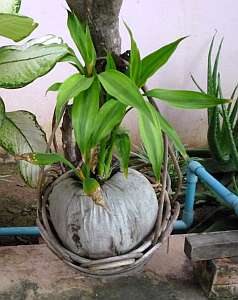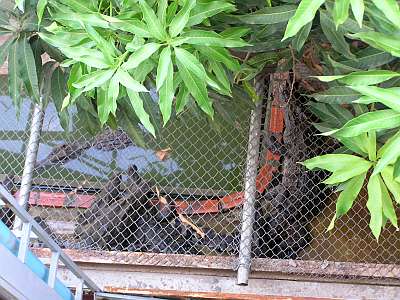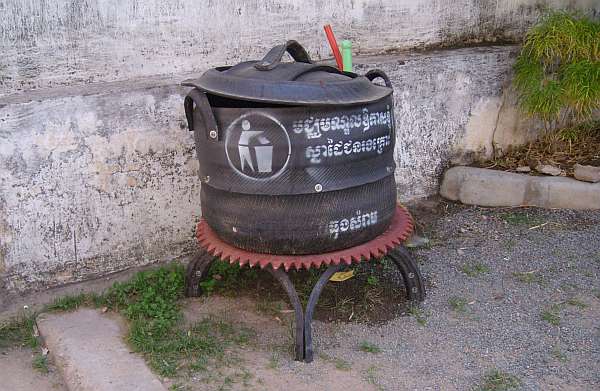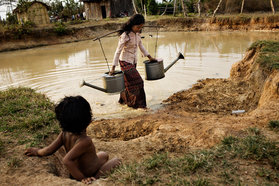Anything Grows (14 October)
Cambodian Crocodiles (10 October)
First Steps at Recycling (15 March)
Game Hunting Preserve (7 March)
Dam Dilemma (Part 2) (19 February)
Dam Dilemma (19 February)
Childish Behavior (10 February)
14 October 2009
Anything Grows

Because of its tropical climate and abundant rainfall, almost anything will grow in Cambodia at almost any time of the year. Particularly banana and coconut trees are fast-growing and ubiquitous. Here a coconut has been left to sprout and has started growing a new tree.
10 October 2009
Cambodian Crocodiles

These are crocodiles kept in a pen in the house next to our Deaf Development Programme office in Phnom Penh. From the upper floors our students could look down into a cage with 15 of the two-meter long amphibians. That was when we first moved into the office. Shortly afterwards, the bottom dropped out of the crocodile market, and our neighbors were summarily rounded up and carted away. Probably it was too expensive to feed them.
Now crocodile farmers in Cambodia are looking forward to a good year for sale of the crocodile skins produced by an estimated 1,000 farms with about 10,000 crocodiles. Cambodian crocodiles do not produce high-quality skins so most of the farmers here raise baby crocodiles which they then sell to the big producers in Thailand and Vietnam. One drawback to the rising price of crocodile skins is that it could encourage local people to start poaching the wild animals that are native to the country's streams and swamps.
15 March 2009
 A start at recycling and re-usingEnvironmental concerns are not high on the list of issues on which people focus here. Most people, many of them barely above the survival level, have literally never heard of concern for the environment beyond what has an impact on their little plot of rice and a vegetable garden. But some NGOs are introducing an awareness of the environment and its protection, and beginning steps at recycling and re-using have been made. This trash container, made from discarded tires, is an initial effort at a green awareness. This one is at the Catholic church in northeastern Phnom Penh, along the Tonle Sap River. |
7 March 2009
Cambodian Game Hunting Preserve
 A Spanish safari company has won Cambodian government approval, after three years of discussion, to establish a wildlife preserve where the animals can be hunted. Conservationists are concerned because one of the attractions in the preserve in the northeast of the country is the Indian bison or gaur. There may be only 50 to 80 gaur left in the wild in Cambodia and wildlife groups fear even limited hunting may push this species, now labeled as "vulnerable," toward extinction in the country. On the other hand, an official of a rights group approved of the plan if it would employ local minority people. He says their love for wildlife would make the project successful. We can only wait and see since matters like this, which involve privilege and rewards for the rich, are seldom reversed.
A Spanish safari company has won Cambodian government approval, after three years of discussion, to establish a wildlife preserve where the animals can be hunted. Conservationists are concerned because one of the attractions in the preserve in the northeast of the country is the Indian bison or gaur. There may be only 50 to 80 gaur left in the wild in Cambodia and wildlife groups fear even limited hunting may push this species, now labeled as "vulnerable," toward extinction in the country. On the other hand, an official of a rights group approved of the plan if it would employ local minority people. He says their love for wildlife would make the project successful. We can only wait and see since matters like this, which involve privilege and rewards for the rich, are seldom reversed.
24 February 2009
Dam Dilemma (Part 2)
Guy Lanza is the director of the environmental science program at the University of Massachusetts in the United States and has been studying the effects of hydroelectric power in Asia for forty years. He voices many concerns about the prospect of increased hydroelectric generation in Cambodia:
| "...I completely disagree that hydroelectric power is the best way, or even a good way, to meet energy needs in the region and including Cambodia. I think we should be taking full advantage of the latest technologies that produce energy from renewable green sources. Hydroelectric dam projects have already proven to be ecologically destructive, particularly in South East Asia. Renewable energy technologies, such as solar and wind, are the best options...." |
| "If recent history in the region holds true, it's unlikely that many people in Cambodia will benefit from the electricity produced. About 20 percent of Cambodian households currently have access to electricity. But, recent hydroelectric development projects in Laos have not lived up to their promise of cheap electricity for the local populations." |
| "In my experience, the governments in the region have done a very poor job of providing adequate research and preparation for hydroelectric dam projects in the Mekong River watershed.... The environmental impact assessments produced by the hydroelectric dam proponents are typically seriously flawed or outright shallow and incomplete." |
19 February 2009
Dam Dilemma
 Less than 20% of Cambodian people have electricity, and what is available is unreliable and very expensive. The demand for electricity continues to increase, especially to support development the country greatly needs. However, there is great fear on the part of NGOs and affected communities that Cambodia's development through hydroelectric generation will cause immense harm to the country.
Less than 20% of Cambodian people have electricity, and what is available is unreliable and very expensive. The demand for electricity continues to increase, especially to support development the country greatly needs. However, there is great fear on the part of NGOs and affected communities that Cambodia's development through hydroelectric generation will cause immense harm to the country.
Imaging Our Mekong website recently noted some of the pros and cons concerning proposed generation of electricity by building more dams in Cambodia:
|
Cambodia is on the threshold of a major experiment with hydropower development...business interests particularly from China, are keen to make Cambodia a major generator of hydropower....
As he told a donors’ meeting last year, Cambodia’s Foreign Minister Nor Namhong said that his government wanted Cambodia to be the “battery of South-east Asia”.... Cambodian and international NGOs are warning that large-scale hydropower development could create serious problems, impacting on some of the country’s most pristine ecosystems and reducing water flow and fisheries with major consequences for the livelihoods of thousands of people. As is the case with much government policymaking in Cambodia, exactly what the real decision-making process is in relation to hydropower is a major issue for NGOs, who say the process completely lacks transparency.... “The biggest barrier is actually getting to talk with the Cambodian government about what is going on,” said San. “They just treat as us opponents, as people who complain and create problems.” While a plethora of departments and regulatory bodies participate in the process, observers say the agenda appears to be largely set by the Ministry of Industry Mines and Energy, with direct support of Cambodian Prime Minister Hun Sen. |
That last paragraph likely means that the government will go ahead and do what it wants, building the dams in the typical Cambodia fashion, with little or no transparency, little or no information given to the public, no officials willing to take responsibility for decisions, inadequate environmental impact studies--and basically everyone doing what Prime Minister Hun Sen wants. Law, regulation, environmental requirements, good practices all mean next to nothing in Cambodia.
[Photo from DanChurchAid]
10 February 2009

Childish Behavior